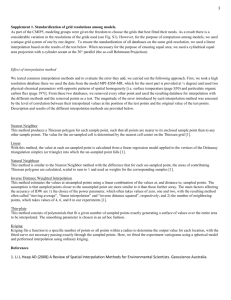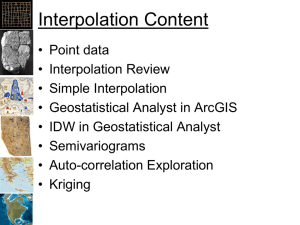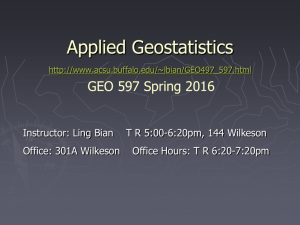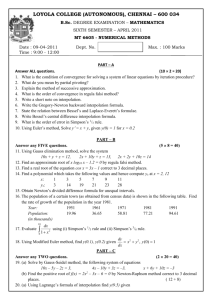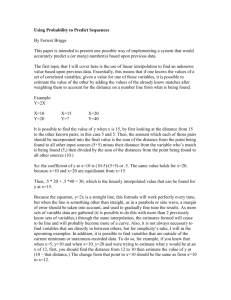Hunter.ppt
advertisement
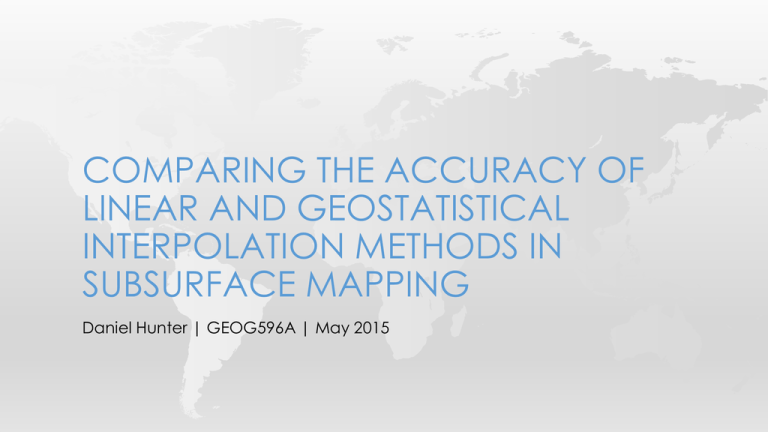
COMPARING THE ACCURACY OF LINEAR AND GEOSTATISTICAL INTERPOLATION METHODS IN SUBSURFACE MAPPING Daniel Hunter | GEOG596A | May 2015 OBJECTIVE Illustrate the potential improvements in accuracy gained through the use of geostatistical interpolation over traditional linear interpolation methods for the generation of a surface representing a rock layer on a small site in Central America. OUTLINE • Timeline • Schedule • Venue • Background • Depth to rock and why it matters • Types of Interpolation • Linear interpolation • Geostatistical interpolation • Project Methodology • Data preparation • Subset data • Interpolation workflows • Iterations • Accuracy evaluation • Results aggregation • Anticipated Results • Which proved more accurate and why? TIMELINE • Schedule • May 2015 • • • • • Draft report October 2015 • • Complete methodology September 2015 • • Finalize and submit abstract August 2015 • • • Finalize methodology and report November 2015 • • Finalize workflow Develop Python code July 2015 Present GSA Conference Venue (I HOPE!) • Present to PSU June 2015 • • • • • Geologic Society of America Annual Conference Baltimore, MD November 1 – 4, 2015 GEOG596B • • Start – October 2015 Complete – December 2015 BACKGROUND • • Estimating the Unknown • What’s beneath the surface? • Depth to bedrock, minerals, water Why Does it Matter? • Construction, engineering and mining • Accuracy of Digital Data • Boreholes, wells, test pits, profiles • Interpolation Selection Methods • Which one and why? • Purpose of Study • Confidential however… Reference: Kumler, Felus, Meyer, samui, Verdee, Yilmaz INTERPOLATION The process of using known values at fixed locations to estimate unknown values at all other locations to derive a representative continuous surface. (KT Chang) • Control Points • Singular input to surface • Types of Interpolation: • Local vs. Global • Deterministic vs. Stochastic • Exact vs. Inexact Reference: Chang, KT, O’Sullivan, Longley TYPES OF INTERPOLATION Trend Spline Thiessen Kriging IDW TIN Table Adapted From: Chang, KT. (Table 15.1) Reference: Chang, KT, O’Sullivan, Longley TIN’S • • Triangulated Irregular Network • Terrain modeling • Control points • Polygons • Delauney Triangulation Logic • Connect points • Form triangles • Triangle becomes planes Reference: Chang, KT, O’Sullivan, Longley, Kumler LINEAR INTERPOLATION • • • • Local first order planar polynomial interpolation Convert TIN to raster Faces assume constant slope and aspect Cell value is a function of the XY (cell center) projected onto the face Reference: Chang, KT, O’Sullivan, Longley GEOSTATISTICAL INTERPOLATION Kriging • Semivariogram • Axes Semivariance • Binning • Anisotropic • Isotropic Models • Nugget • Range • Sill • Partial Sill • • Inset Image Reference: ArcGIS Online Resource Center Reference: Chang, KT, O’Sullivan, Longley GEOSTATISTICAL INTERPOLATION • Ordinary Kriging • Assumes the absence of drift • Uses fitted semivariogram directly • Universal Kriging • Assumes drift or trend in samples Reference: Chang, KT, O’Sullivan, Longley PROJECT METHODOLOGY • • • • • • Data preparation Subset data Interpolation workflows Iterations Accuracy evaluation Results aggregation DATA ACCESS AND PREPARATION • Data Access • Data is currently in my possession • Historic database containing over 500 borings • Project study site • • • Area of project Average depth Data Preparation • Data will be reviewed for outliers and anomalies • • • • • Visual inspection Tabular inspection Regression surface comparison Spatial statistics Semivariogram SUBSET • • • • 100% starting sample (500 Borings) 75% used for interpolation (375 Borings) 25% used for validation (125 Borings) Randomly generated subsets LINEAR INTERPOLATION • • • • 75% sample for input Top of rock elevation values Points converted to TIN TIN to raster – through linear interpolation GEOSTATISTICAL INTERPOLATION • • • • 75% sample of borings for interpolation Top of rock elevation values used for interpolation Semivariogram fitting Interpolation performed with ordinary kriging or universal kriging – TBD • Further data investigation required • Trend, visual, tabular, semivariogram, histograms ITERATIONS • • Python and GeoProcessing Methodology will be performed numerous times • 1000 runs for each surface type • • • • Different 75% sampling every simulation Different 25% sampling every simulation Different surfaces every simulation Different residuals every simulation Image Reference: ArcGIS Online Resource Center ACCURACY EVALUATION • Validation (Cross-Validation) • Actual vs. Estimated using 25% • Subtract estimated from actual • RMSE • • Available for exact local methods More than just an XY statistic Reference: Chang, KT, O’Sullivan, Longley RESULTS AGGREGATION • • Consolidate boring differences for results Aggregate to a summary table • Surface by surface • • • After 1 run calculate RMSE for each surface After 1000 runs conclude which RMSE was more frequently lower Entire simulation • • • After 1000 runs calculate RMSE for entire sampling (~125,000 residuals) Lower RMSE is the more accurate surface Summary statistics • Overall distribution, histogram, variance, etc Surface by Surface Method Entire Simulation Method ANTICIPATED RESULTS • • • • Optimistic results will be better with the kriging work flow given the large scale trends in the data. Conclusions will be made statistically… TIN surfaces are traditionally less accurate and yield higher errors than those of the kriging method (Felus, 2005) Historical data poses potential issues Selection of appropriate semivariogram model 1000 time will be a challenge Reference: Felus, Yilmaz, Samui REFERENCES Chang, Kang-tsung. Introduction to Geographic Information Systems. McGraw Hill, New York, New York, 2012. Esri ArcGIS Resource Center, Accessed 2014 Felus, Yaron A, Saalfel. Delaunay Triangulation Structured Kriging for Surface Interpolation. Surveying and Land Information Sciene March 2005. Kumler, M. P. An Intensive Comparison of Triangulated Irregular Networks (TINs) and Digital Elevation Models (DEMs). Cartographica , 31 (2), 1-99. 1994. Longley, Paul, et. al. Geographic Information Systems and Science, Wiley, West Sussex England, 2005. Meyer, Thomas. The discontinuous nature of Kriging interpolation for digital terrain modeling. Cartography and Geographic Information Science - October 1, 2004. O'Sullivan, David. Geographic Information Analysis. John Wiley and Sons. 2010 Samui, Pijush. Application of Geostatistical Models for Estimating Spatial variability of Rock Depth. Scientific Research Engineering. September 2011. T. S. Virdee & N. T. Kottegoda. A brief review of kriging and its application to optimal interpolation and observation well selection, Hydrological Sciences Journal, 29:4, 367-387. 1984 Yilmaz, Murat. The effect of interpolation methods in surface definition: an experimental study. Earth Surf. Process Landforms 32, 1346 - 1361 2007. QUESTIONS

